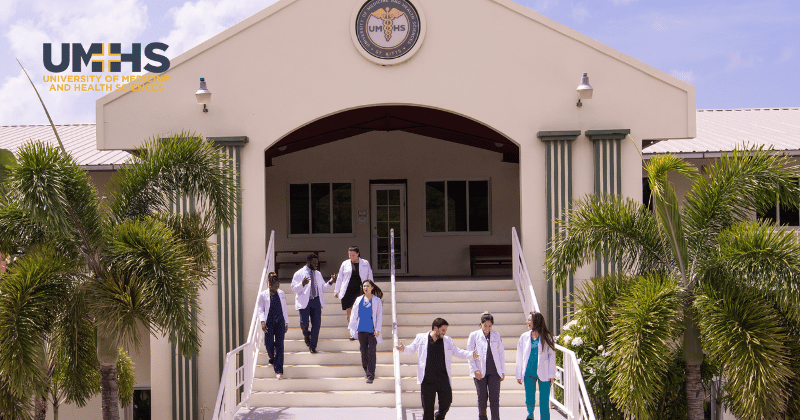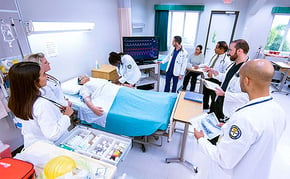Gaining admission to medical school is a significant achievement that opens the door to exceptional career opportunities, substantial financial rewards, and considerable prestige in both the United States and Canada. According to the Association of American Medical Colleges (AAMC), the average GPA for matriculating medical school applicants in the 2023-2024 academic year was 3.71, with an average MCAT score of 511.7. As anticipated, the competition for medical school admission is highly intense.
In this article, we will provide valuable insights on how to gain admission to medical school and address some of the most frequently asked questions posed to our admissions officers. Additionally, we will compare the admissions process of one of the top Caribbean medical schools, UMHS, with those of medical schools in the United States and Canada.
Quick Navigation Links + FAQs
- Can I get into med school with bad grades?
- Can I get into med school with a low MCAT?
- How to get into med school from high school?
- When should I submit my completed med school application?
- Can I get into med school with a psychology or other non premed degree?
- What percentage of applicants get into medical school?
- What are the easiest medical schools to get into?
- How is medical college admission different at UMHS than at US medical schools?
- What do med school admissions experts look for in an applicant at UMHS?
- How to get started in med school at UMHS?
Can I get into medical school with bad grades?
Gaining admission to medical school with a GPA below 2.50 is uncommon. Most medical schools have a minimum GPA requirement of 3.0 and do not consider applicants with lower GPAs, even if they have an exceptional MCAT score. In 2023, the average GPA for matriculating allopathic medical students was 3.71, while osteopathic medical students had an average GPA of 3.54. Despite these high averages, some students with lower GPAs do matriculate into medical school.
Applicants with lower grades or MCAT scores can improve their chances by:
- Taking additional courses, particularly science courses, to improve GPA.
- Gaining experience in the medical field through shadowing physicians or working in health-related roles, such as a medical scribe or paramedic.
- Participating in scientific research projects.
- Getting involved in volunteering and other extracurricular activities outside the medical field.
- Sharing a unique and personal story about their motivation to become a doctor in their personal statement.
- Thoroughly preparing for and rehearsing all interviews.
Read more about GPA requirements at UMHS here.
Can I get into any medical schools with a low MCAT Score?
Most medical schools place significant emphasis on MCAT scores for admissions decisions. A low MCAT score does not entirely preclude the possibility of gaining admission to medical school, but it can limit the number of schools willing to consider an applicant. Many institutions utilize automated systems to filter out candidates who fall below a certain MCAT threshold. However, some schools may accept students with lower MCAT scores if they have a high GPA or other application strengths. Data from various sources indicates that an MCAT score below 501 excludes many applicants from consideration at both US allopathic and osteopathic medical schools. It is advisable to consult the Medical School Admission Requirements (MSAR) database tables to identify schools where an applicant may be competitive. For those scoring below typical acceptance levels, retaking the MCAT with improved study strategies or enrolling in a specialized master’s program (post-baccalaureate) can be beneficial. Additionally, attending a top Caribbean medical school, such as the University of Medicine and Health Sciences (UMHS), may also be a viable alternative. More information can be found here.

How to get into Medical school from high school?
The most common path to medical school after high school involves the traditional route, which includes:
- Gaining acceptance into an undergraduate university
- Completing all prerequisite courses
- Taking the Medical College Admission Test (MCAT)
- Applying to medical schools
- Completing an undergraduate degree
Alternatively, students can pursue a combined program, such as a Bachelor of Science/Doctor of Medicine (BS/MD) program, directly from high school. Many of these programs last 8 years, the same as the traditional route, but some are 7 years long, reducing the undergraduate portion to 3 years. Certain programs may not require the MCAT. These combined programs are highly competitive, with acceptance rates typically below 10%.
When should I submit my completed Medical school application?
Medical school applications should be submitted as early as possible due to the highly competitive nature of the admissions process. Early submission offers a significant advantage, with most medical college admission specialists recommending late May or very early June as the optimal time-frame. Delaying the submission can cause applicants to miss the “early application advantage,” which increases the likelihood of being accepted into a preferred medical school. For a detailed timeline of the medical school application process, refer to the comprehensive guides available online.
Can I get into med school with a psychology or other non premed degree?
Yes, students with a psychology or other non-science major can gain admission to medical school. According to the AAMC, statistics show that a higher percentage of students with majors in humanities, math, statistics, and physical sciences matriculate into medical school compared to those in biological sciences and specialized health sciences fields. Some medical school admissions advisors even recommend that applicants major in one of the “easier” non-premed categories to boost their GPA
What percentage of applicants get into Med school?
The latest data from the Association of American Medical Colleges (AAMC) indicates that in 2023, the matriculation rate for applicants to U.S. allopathic medical schools (MD degree) was around 43%, with 22,262 matriculants out of 51,423 applicants. Similarly, data from the American Association of Colleges of Osteopathic Medicine (AACOM) for the same year shows a matriculation rate of 32% for osteopathic medical schools (DO degree), based on 8,516 matriculants from 27,277 applicants.

What are the easiest Medical schools to get into?
There are three different ways the question “What are the easiest Medical schools to get into?” can be answered. This includes:
- Easiest schools to get into via lowest median GPA
- Easiest schools to get into via lowest MCAT scores
- Easiest schools to get into via highest acceptance rate
There are many online sources that discuss the easiest schools to get into however, the schools listed vary heavily. The following are listed on multiple websites and may be worth looking into:
- UAMS College of Medicine
- Meharry Medical College
- University of North Dakota School of Medicine and Health Sciences
- LSU Health Sciences Center in Shreveport
- Western University College of Osteopathic Medicine of the Pacific
- Debusk College of Osteopathic Medicine
A larger listing of the easiest medical schools to matriculate into can be found here.
If you are suffering from a less-than-desirable GPA or MCAT exam score, please check out why UMHS may be a good choice in med schools and one of the easier schools to get into by reading this section.
How is medical college admission different at UMHS then at US Medical schools?
The main difference between The University of Medicine and Health Sciences and other medical schools is that admission is based on a holistic review of each applicant instead of a computer-based screening algorithm that overweighs MCAT scores and GPA. This allows our medical school admissions teams to find highly qualified students that other colleges might miss.
Other advantages include:
• Rolling admissions – Enrollment periods 3 times a year in January, May and September.
• A minimum 3 years of undergraduate college education, 90 semester credits, instead of 4 years.
• “ARP” prep program is available for students needing added academic preparation and/or the development of better study skills for the rigors of Medical school.
• Students are evaluated individually for work experience, research experience, volunteering experience, and trajectory of academic performance.
• A pre-medicine science major is not required.
• Life experience evaluated for non-traditional and grad students.
• Careful consideration is given to students wanting to become practicing physicians in underserved areas.
What do Med school admissions experts look for in an applicant at UMHS?
At UMHS, our medical school admissions officers carefully evaluate if prospective students possess the dedication and educational drive to excel in Medical school. Besides looking at MCAT scores and GPA, factors such as leadership, research skills, life and work experience, and trajectory of academic achievement. In addition, a student’s letters of recommendation, personal statement, and extracurricular activities are evaluated holistically without the use of computer algorithms.
How to get started in Med school at UMHS?
For more general information about getting started in a medical career at our our highly-rated Medical school in the Caribbean click this link. If you want to find out for sure if you qualify for medical school at UMHS please contact one of our med school admissions officers and discuss your opportunities for a career in Medicine. You can also get started by uploading your AMCAS or AACOMAS application for free here.
Popular and related articles:

Callie Torres is a double board-certified physician, a freelance health and medical writer, as well as an author of many peer-reviewed medical articles.



















